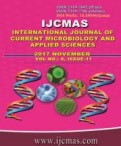


 National Academy of Agricultural Sciences (NAAS)
National Academy of Agricultural Sciences (NAAS)

|
PRINT ISSN : 2319-7692
Online ISSN : 2319-7706 Issues : 12 per year Publisher : Excellent Publishers Email : editorijcmas@gmail.com / submit@ijcmas.com Editor-in-chief: Dr.M.Prakash Index Copernicus ICV 2018: 95.39 NAAS RATING 2020: 5.38 |
This study focused on the growth rate and production of the Indole Acetic Acid (IAA) hormone and the ability of rot fungus to dissolve phosphate. A total of 15 rot fungi isolated from oil palm empty fruit bunches (EFB). The growth rate of isolates identified on Potato Dextrose Agar (PDA) which have been incubated for 7 days on a petri dish (á´“ 9 cm) with a temperature of 30 °C, measured by the diameter of the colony every day. Isolates TK-14 reaches maximum diameter on the 3rd day, while the other isolates achieve maximum growth in the 4th and 7th. Out of the 33 isolates of the fungus, 15 isolates were found to have the ability to produce hormones IAA. IAA production tested at Pikovskaya Broth media and measured using a spectrophotometer. Rot fungus has the ability to produce IAA with the concentration range of 0.048-8.429 mgl-1. Isolates TK-8, TK-2, and TK-14 have the highest concentration of IAA. Similarly, the ability to dissolve the phosphate also varies between 5.272-10.620 mgl-1. Three isolates were recommended to degrade the oil palm empty fruit bunches in future studies.
 |
 |
 |
 |
 |